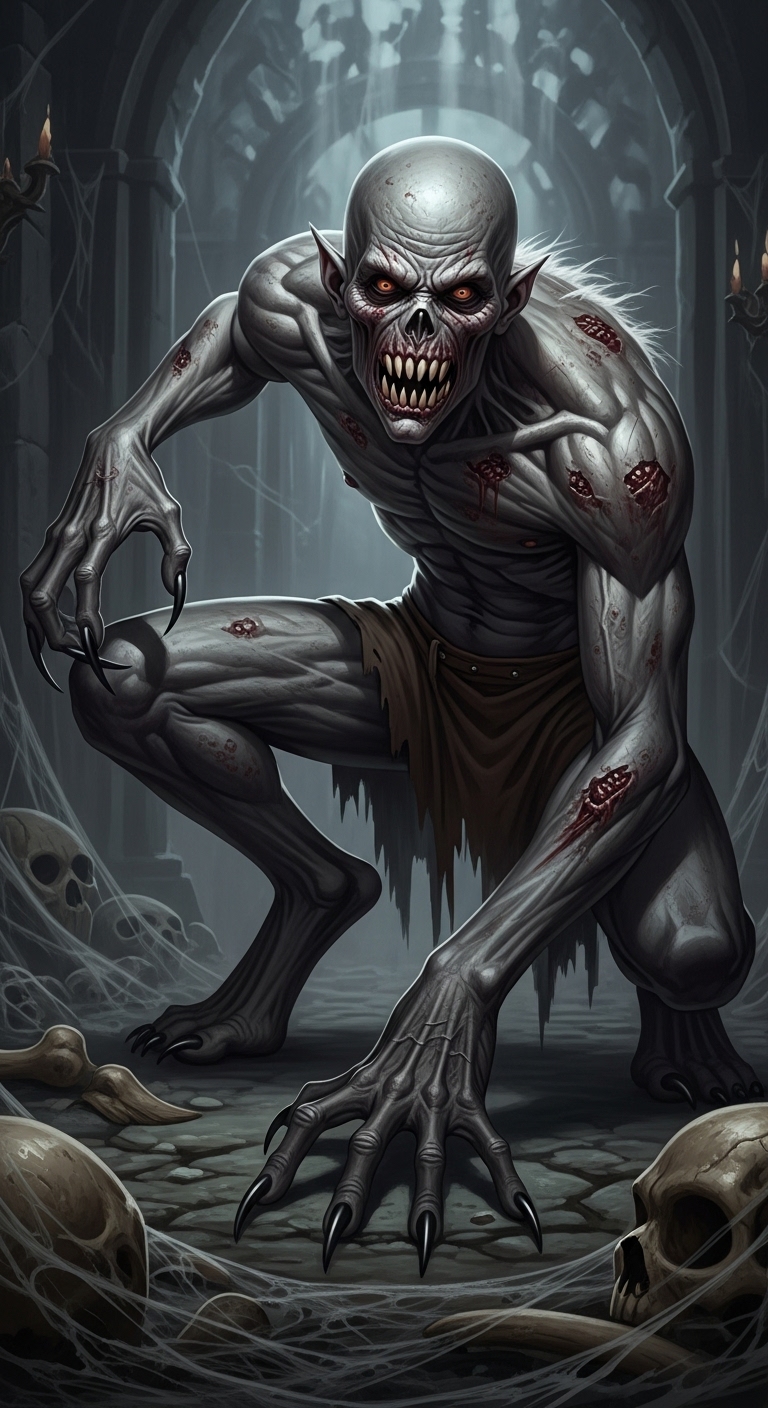Ghoul

- Size: Medium
- Type: Undead
- Alignment: Chaotic Evil
- AC: 12
- Initiative: +2 (12)
- HP: 22 (5d8)
- Speed: 30 ft
| ATTR | VAL | MOD | SAVE |
|---|---|---|---|
| STR | 13 | +1 | +1 |
| DEX | 15 | +2 | +2 |
| CON | 10 | +0 | +0 |
| INT | 7 | -2 | -2 |
| WIS | 10 | +0 | +0 |
| CHA | 6 | -2 | -2 |
- Immunities: Poison; Charmed, Exhaustion, Poisoned
- Senses: Darkvision 60 ft.; Passive Perception 10
- Languages: Common
- CR: 1 (XP 200; PB +2)
Actions
Multiattack. The ghoul makes two Bite attacks.
Bite. Melee Attack Roll: +4, reach 5 ft . Hit: 5 (1d6 + 2) Piercing damage plus 3 (1d6) Necrotic damage.
Claw. Melee Attack Roll: +4, reach 5 ft . Hit: 4 (1d4 + 2) Slashing damage. If the target is a creature that isn't an Undead or elf, it is subjected to the following effect. Constitution Saving Throw: DC 10. Failure: The target has the Paralyzed condition until the end of its next turn.
Lore & Background
Ghouls are ravenous undead creatures driven by an insatiable hunger for humanoid flesh, particularly the soft tissues and organs of the recently deceased. These foul beings were once humanoids themselves, transformed by exposure to ghoul fever, necromantic curses, or consuming the flesh of other ghouls. The transformation strips away much of their former personality, leaving behind a cunning predator with just enough intelligence to hunt effectively.
Unlike mindless zombies, ghouls retain enough cognitive function to use tools, set simple traps, and coordinate with others of their kind. They are drawn to graveyards, battlefields, and other places where fresh corpses can be found. Ghouls typically hunt in packs, using their paralytic claws to incapacitate victims before dragging them back to their lairs for consumption. Their presence is often preceded by reports of grave robbing and missing corpses.
Combat Tactics
Ghouls are pack hunters who use their Paralyzing Claw attacks to immobilize prey before moving in for the kill. They prefer to attack from ambush, using their Darkvision and knowledge of their territory to gain advantages over living opponents. Their Bite attack deals significant damage and can spread ghoul fever to humanoid victims.
When fighting in groups, ghouls coordinate their attacks to maximize the number of paralyzed victims. They focus on spellcasters and ranged attackers first, knowing that paralyzed enemies are helpless against their feeding frenzy. Ghouls are cowardly when faced with superior force, preferring to retreat and hunt easier prey rather than fight to the death.
Encounter Ideas
The Defiled Cemetery: A pack of ghouls has taken residence in an old cemetery, digging up fresh graves and terrorizing mourners who come to pay their respects. The local clergy has hired the party to cleanse the sacred ground.
Plague Ship: A merchant vessel arrives in port with its crew transformed into ghouls after being infected during their voyage. The party must board the ship and deal with the undead crew before the contagion spreads to the city.
The Cannibal Cult: A group of desperate survivors in a remote village has turned to cannibalism during a harsh winter, unknowingly transforming themselves into ghouls. The party must decide whether to destroy them or try to find a cure.
Underground Feast: Ghouls have been stealing corpses from a city's morgue through the sewer system, creating a vast underground lair filled with the remains of their victims and the stench of decay.
Environmental Effects
Ghouls leave clear signs of their presence through their feeding habits and territorial behavior. Disturbed graves with claw marks on coffins and scattered bones mark their hunting grounds. The stench of decay lingers in areas they frequent, and carrion birds may circle overhead, drawn by the smell of death.
Vegetation around ghoul lairs often withers and dies, while water sources may become contaminated with disease. Animal tracks show that most wildlife avoids these areas, leaving an unnatural silence broken only by the sounds of the ghouls' feeding.
Treasure
Ghouls are primarily interested in flesh rather than material wealth, but their lairs often contain items scavenged from their victims. Coins, jewelry, and personal effects may be scattered among the bones and refuse of their feeding grounds. Weapons and armor are typically ignored unless they're particularly shiny or catch the ghouls' attention.
Grave goods stolen from tombs and crypts might include religious artifacts, family heirlooms, and burial treasures. Some items may be cursed or have religious significance, requiring careful handling or proper consecration.
Plot Hooks
The Ghoul King: An intelligent ghoul has begun organizing other ghouls into a more structured society, threatening to create an undead kingdom that could challenge the living. The party must stop this emerging threat before it grows too powerful.
Infection Vector: A ghoul has been deliberately spreading its curse to create more of its kind, targeting specific individuals for transformation. The party must track down the source of the infections and find a way to cure the recently transformed.
The Hungry Dead: A famine has driven ghouls out of their traditional hunting grounds and into populated areas, where they compete with desperate living humans for scarce resources. The party must find a way to end the crisis before society collapses.
Ancestral Curse: A noble family's ancestor has risen as a ghoul, cursing the bloodline and causing family members to transform upon death. The party must break the curse and put the original ghoul to rest before the entire lineage is consumed by undeath.